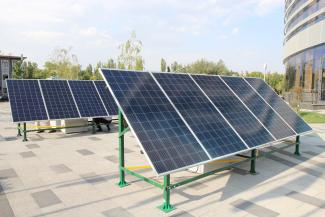Transforming Uzbekistan’s Energy Sector for a Sustainable Future
Under the Soviet Union, Uzbekistan played a pivotal economic role due to its central geographic location and rich culture including its importance to the Silk Road. All of Central Asia’s energy system was managed from Uzbekistan.
After the collapse of the Soviet Union in 1991, Uzbekistan followed an isolationist foreign policy, remaining closed for a long time. Starting in 2016, under President Shavkat Mirziyoyev, the country has begun a transformation. In addition to opening up the economy, stabilizing the currency and reducing inflation, Uzbekistan has been able to increasingly attract foreign investment.
However, the country’s infrastructure, including its energy systems and equipment, is outdated. There was a lack of investment in the upkeep of the energy infrastructure as it aged over three decades.
While today, conventional power plants are being repaired, unfortunately they don’t run efficiently. Many of the country’s power plants need a complete overhaul.
INTEGRATING RENEWABLE ENERGY
Integrating renewable energy into the national power system is difficult because it needs constant adjustments and central control by a dispatcher with remote access to enable an economic dispatch, meaning utilizing the cheapest energy generated at any given time from across the energy system.
For instance, California’s energy grid is built such that it is digitally monitored and changed every five minutes by an operator, who makes decisions on ramp up and ramp down of a flexible power plant. Every five minutes, the schedule is adjusted for the next few hours. That’s the most optimal way to operate a grid with a high concentration of renewable energy. Since renewable energy fluctuates and needs constant adjustments to ensure an uninterrupted energy supply it needs close monitoring.
California has 15 dispatchers monitoring the state’s energy grid; in contrast, Uzbekistan has five dispatchers.
In Uzbekistan, changes to energy generation are made once every hour versus every five minutes in California. “This doesn’t work for renewables because if you cannot manage variability, it can lead to constant accidents,” says Oleg Ryaskov, USAID’s Central Asia Regional Electricity Market, Deputy Chief of Party.
In Uzbekistan, power plant site operators receive instructions to adjust the energy grid over the phone and make adjustments manually. Additionally, power plants are used equally or based on a fixed schedule instead of using energy generated at the lowest cost.
NEW SOLAR POWER PLANTS
“Uzbekistan’s first 100 megawatts solar power plant is now operational in the Navoi region and the country is working with international financial institutions (IFIs) to announce tenders for up to two gigawatts of solar energy projects,” says Abdulajon Otaboyev, Head of Uzbekistan’s Department for the Development of Renewable Energy.
Abdulajon adds, “We are receiving valuable assistance from USAID on regulating the uncertainty of the renewable energy sources. Additionally, USAID is providing us technical assistance and training for our dispatchers.”
THE NEED TO MODERN UZBEKISTAN’S ENERGY GRID
Uzbekistan’s energy grid development is far behind what it needs to be. “If the grid isn’t modernized, the only solution will be curtailment, meaning limiting the amount of energy you can use from a renewable power plant because the energy cannot be consumed by the existing grid,” says Oleg.
The cost of integration (upgrading the energy grid) is very high in Uzbekistan. In contrast, this cost in the United States is significantly lower because the grid is already advanced, digitized, and automated. “The cost in Uzbekistan is high because it’s not just about adding flexible energy generation that’s absolutely necessary, but you need to overhaul the entire system and grid, change dispatch disciplines, change dispatch intervals, among other necessary changes,” explains Oleg.
USAID’S PARTNERSHIP WITH UZBEKISTAN
Beginning in 2017, USAID has been assisting Uzbekistan with assessments and studies to determine next steps as it prepares to upgrade its energy system. USAID currently is conducting studies on what is needed, what are the country’s energy priorities, when and what should be done and what it will cost, how much flexible generation is needed, what upgrades need to be made to the grid, what changes are needed in operations, and what is the country’s energy forecast. USAID is playing a vital, advisory role.
In Uzbekistan, USAID is training Uzbekistan’s energy experts, enabling them to plan for themselves. “It takes longer to train than to implement directly. International banks such as the EBRD and World Bank cannot do this. They need to deliver results and stick to a budget plan determined at the start of a project,” explains Oleg.
“USAID is making a longer-term investment and has the flexibility to adapt operations based on a country’s changing needs. USAID has a budget for capacity building and the flexibility to change operations like in project management, based on real-world developments,” adds Oleg.
It’s a long way before Uzbekistan will complete upgrading its energy system. It may take about a decade before Uzbekistan gets there. This is only the beginning. But it’s a start in the right direction.
GREEN ENERGY FOR A BRIGHTER FUTURE
“In 2019, the government adopted a law on renewable energy and set up subsidies for energy users to encourage the move to clean energy sources. We have set a target of 25 percent of renewable energy (solar, wind, and hydro) generation by 2030 and we are going to achieve it,” says a confident Abdulajon. In 2021, the Government of Uzbekistan announced its goal to be carbon neutral by 2050.
As Central Asia’s most populated nation, Uzbekistan is taking the necessary steps to tackle climate change by reducing its reliance on fossil fuels and transitioning to clean energy.

Олег Рясков для USAID “Power the Future”
